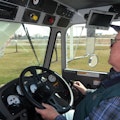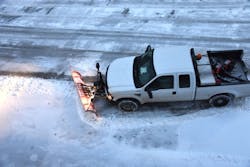Using Pickup Trucks as Snow Plows
Although municipalities and state road departments buy medium- and heavy-duty trucks, private operators tend to use pickups and other light and medium-duty trucks, along with the equipment to turn them into plows and spreaders, says Brian Birch, chief operating officer with the Snow & Ice Management Association, whose members are commercial operators. Some employ wheel loaders and other machinery. “It’s bigger than you’d think,” he said of the commercial side, with vehicle and equipment sales totaling $18 billion annually compared to $2 billion to $3 billion for the public sector.
“There are about 88,000 sole proprietors, plowing contractors and landscapers, and 22,000 to 23,000 larger commercial operators,” he said. The segment is large because “there are more parking lots that need to be cleared than roads.… It’s been pushed by fears of liability from slips and falls.”
Though some ½-ton pickup trucks are outfitted for plowing, most are ¾- and 1-ton 4x4s, what builders call heavy duty. Manufacturers offer snow-plow packages that usually include stronger front axles and suspensions, beefed-up steering parts, higher-output alternators, larger radiators, transmission coolers, and other components. Four-wheel drive is wise because these trucks don’t carry as much salt and sand as bigger trucks, so need mechanical traction to compensate.
How do you spec a snow plow truck?
The many suppliers that make plow blades and mounts, spreaders, and other equipment also offer packages designed for specific makes and models. There are 150 supplier-members of SIMA, Birch said. Major ones are Western, Fisher and SnowEx, all owned by Douglas Dynamics, and Boss, Buyers Products, Myers. A walk through a trade gathering, like the Work Truck Show in Indianapolis, reveals many more. A big innovation in plow tech in last 20 years are articulating blades that can take different shapes, all operated hydraulically.
Landscapers can fill in idle winter months with plowing work, and many SIMA members are landscapers. Because snow fall differs from season to season – some winters it snows a lot, others little at all – financial planning must be done on a three- to five-year basis. Then there’s the residential side that’s tough to serve. “You have to sell to individual households,” Birch says, “everyone wants to be first, and you have to worry about vehicles sitting in the driveway when you show up.”
About the Author

Tom Berg
Tom Berg is widely acknowleged as one of the top truck writers in the industry. He has covered construction for more than 34 years, and has test-driven well over 150 trucks for Construction Equipment.
